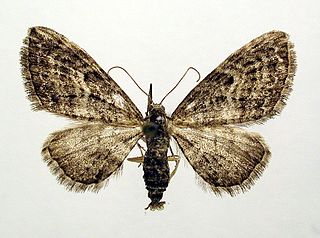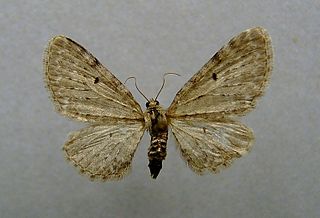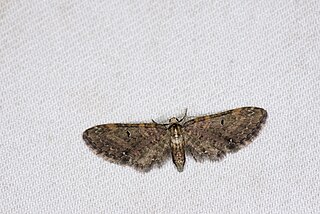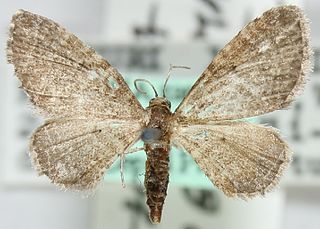
The common pug(Eupithecia vulgata) is a moth of the family Geometridae. It is a common species across the Palearctic region, including the Near East and North Africa. It ranges from the Atlantic coast of Ireland and Portugal across Europe, the Middle East and Central Asia to the Russian Far East (Priamurje) and Korea.

The larch pug is a moth of the family Geometridae. The species can be found in Europe, the Ural Mountains, West and Central Siberia, the Altai Mountains, Transbaikalia, Yakutia, the Far East, Mongolia, Korea, Japan and in North America, from Yukon and Newfoundland to New York and Arizona.

Eupitheciini is a tribe of geometer moths under subfamily Larentiinae, often referred to as pugs. The tribe was described by Tutt in 1896.

Eupithecia jezonica is a moth in the family Geometridae. It is found in Asia, including India and Nepal. It has also been recorded from Kazakhstan, the Russian Far East and Korea, Japan and Taiwan.

Eupithecia veratraria is a moth of the family Geometridae first described by Gottlieb August Wilhelm Herrich-Schäffer in 1848. It is found from the mountainous areas of Europe and Asia up to Japan.

Eupithecia distinctaria, the thyme pug, is a moth of the family Geometridae. It is found throughout Europe. It is also found in Iran. from the Iberian Peninsula through western and central Europe including the British Isles as well as further east as far east as far as Russia and Iran. In the north the range reaches as far as the southern Fennoscandia, to the south, where it is more common, it occupies the Mediterranean and Asia Minor. It is found primarily on warm, stony slopes and rocky structures as well as on sparse grassy areas with thyme mounds. In the Alps, it rises to heights of 2000 metres.

Eupithecia quadripunctata is a moth in the family Geometridae. It is found in India, Pakistan, Nepal, Russia, China, Taiwan, Korea, Japan and northern Thailand.
Eupithecia subtacincta is a moth in the family Geometridae. It is found in the Himalaya, from Jammu and Kashmir through China to the Russian Far East, Korea and Japan. It is also found from south-east Asia to Borneo.

Eupithecia convexa is a moth in the family Geometridae. It is found in Taiwan and Thailand.
Eupithecia masculina is a moth in the family Geometridae. It is found in Taiwan and the Philippines.
Eupithecia pamirica is a moth in the family Geometridae. It is found in Afghanistan, Tajikistan, Kyrgyzstan and Pakistan. It is found at altitudes between 1,800 and 3,500 meters.
Eupithecia tshimganica is a moth in the family Geometridae. It is found in Afghanistan, Uzbekistan and Tajikistan.
Eupithecia lindti is a moth in the family Geometridae. It is found in Afghanistan, the mountains of Uzbekistan, Tajikistan, and northern Pakistan and India.
Eupithecia anemica is a moth in the family Geometridae. It is found in the mountains of southern Kazakhstan, Uzbekistan, Kirghizstan, Tajikistan and Pakistan.
Eupithecia dzhirgatalensis is a moth in the family Geometridae. It is found in Tajikistan and Pakistan.
Eupithecia memorata is a moth in the family Geometridae. It is found in the Russian Far East.

Eupithecia homogrammata is a moth in the family Geometridae. It is found in Russia, Japan and Korea.
Eupithecia persuastrix is a moth in the family Geometridae. It is found in the Russian Far East.
Eupithecia tshimkentensis is a moth in the family Geometridae first described by Viidalepp in 1988. It is found in the Russian Far East.
Eupithecia pseudassimilata is a moth in the family Geometridae. It is found in Russia and Japan.








